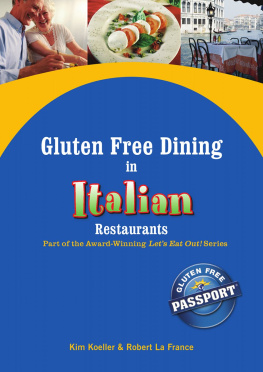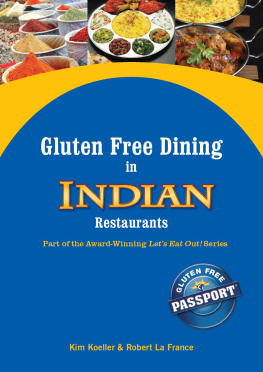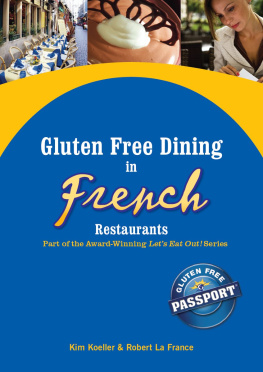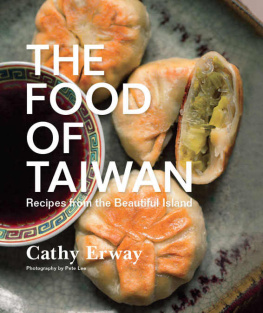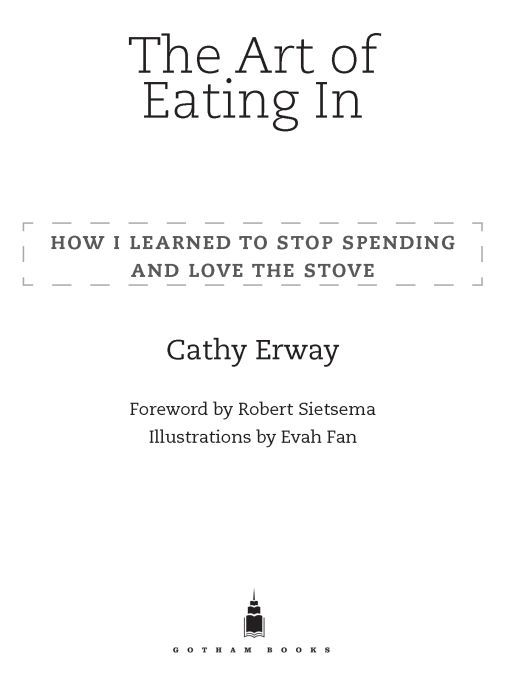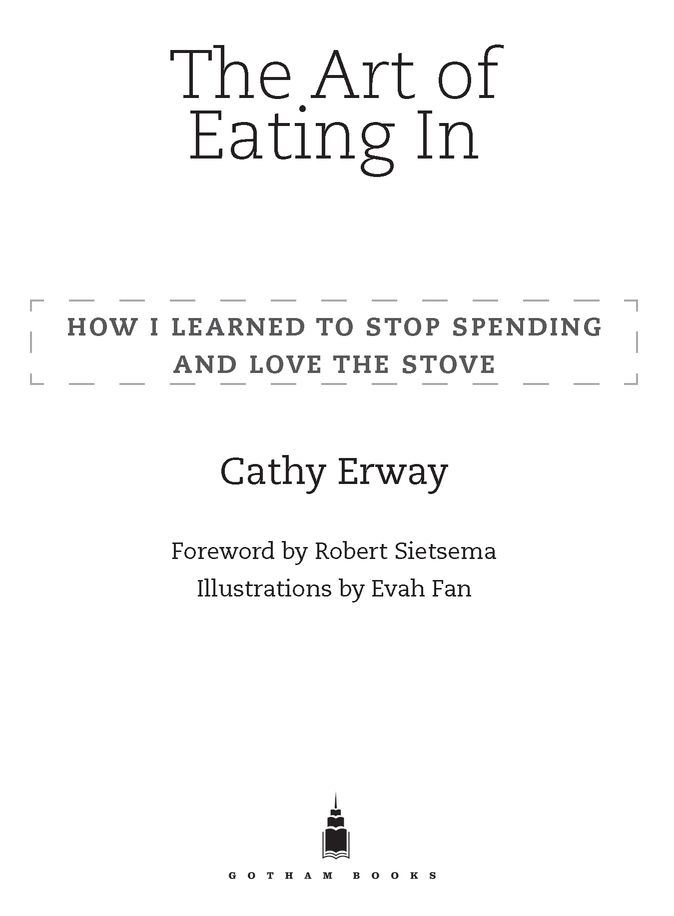Table of Contents
To my parents, for teaching me to cook.
And to my brother, Chris, for helping me do
literally everything else.
A great deal has been written about the amenities of dining, but few writers have seen fit to comment on the very important modern problem of eating in a public place.
-M.F.K. Fisher, D is for Dining Out, An Alphabet for Gourmets
Foreword
I first became aware of Cathy Erway two years ago. As I sat eating in a fancy midtown restaurant, a dining companion leaned over his foie gras torchon and asked confidentially, Have you ever heard of Cathy Erway? Shes decided to not eat out in restaurants for two whole years, and shes blogging about it.
I suppose he expected me to express contempt or outright derision, since my livelihood as a restaurant critic depends on everyone eating out as often as possible. I harrumphed something noncommittal but felt a rush of excitement. What a cool idea, I thought. As a fan of performance artwhich this project surely wasI was instantly intrigued. As a blogger and gung-ho home cook, I couldnt wait to visit the site and see how shed translated action into words.
Her blogNot Eating Out in New Yorkbecame a favorite of mine, and over the next year I checked it often to see what she was up to. The site offered a fascinating potpourri of culinary punditry, practical cooking advice, social observation, and recipes that often featured a running commentary. Moreover, much of her cooking incorporated novel elements that owed nothing to any hidebound culinary school. She was an improvisatory cook, par excellence, and seemed to prefer freestyling with stumbled-on ingredients to simply reading and executing predictable recipes. She also backed up her recipes with details about how much ingredients cost, making her website consumer friendly.
A year later, Erways two-year experiment was up, and I wondered whether Id run into her at one of the culinary events that kept herds of foodies wandering across the city like nomadic tribesmen. I didnt have to wonder longsoon after her experiment ended, I met her for the first time at the loft of Winnie Yang, a mutual friend from the Slow Food Movement, who frequently hosted events in her Fort Greene loft.
Cathy was as skinny as a rail, and half Chinese, two things I hadnt expected from her blog and her name, respectively. She proved a keen conversationalist, and when she told me she was working on a book about her experiences, I wanted to get my hands on a copy. I convinced her that once the thing was finished, she should send me the manuscript.
When it finally arrived in my e-mail inbox with a resounding ping, I sat for several hours reading it. While Id feared it would be merely a collection of material cadged from the website, the book turned out to be quite a different kettle of fish entirely, a narrative for which the website was only a starting point. Not only had she not eaten out, but shed explored all avenues of not eating out, including forays into freeganism, urban foraging, bread baking, competitive cook-offs, agricultural sustainability, and amateur chefing at the dining clubs that were currently popular all over Brooklyn. And who but a virtuoso writer could make the act of cooking itself seem as interesting as a car race or a shipwreck?
She began by pondering, How can you date if you cant go out to dinner? From the answer to that fundamental question flowed new friendships, and, eventually, romance. We see her moving from apartment to apartment, sometimes lucky in love, sometimes not so lucky. One boyfriend continues eating out, even as she cooks delicious food at home. One kitchen is large and commodious, while another is so small she can barely turn around in it. Gadgets come her way; she keeps some and throws others out. We meet her parents and musician brother, along with a cavalcade of other memorable characters, some celebrities in the sphere of foodism, some just extras.
In total, the book is really one womans coming-of-age novel, with recipes, a sort of Portrait of the Artist as a Young Cook. Cathy has a real eye for pictorial detail and knows how to tell a story, complete with dialogue and denouement. Moreover, the book is a birds-eye view of the youth culturewe might call it a counter culture, due to its kitchen orientationduring an era that will be gone in the blink of an eye. Cathy is a combination of Holden Caul-field and Henry David Thoreau, and if she gets her readers out of the restaurants and back into the kitchenat least a few times a weekher experiment will have been a complete success.
Robert Sietsema, food critic,
The Village Voice
Introduction
EATING OUT IN NEW YORK
A few years ago when my friend Ari was apartment hunting, she was shown a two-bedroom in Brooklyn with plenty of sunlight, a patio, a nicely sized bathroom, and a tall industrial sink in one corner of the living room.
Wheres the kitchen? she asked her Realtor, looking around at the unfurnished space. A two-year-old was seated on her hip, and her belly bulged with another little-one-to-be.
The Realtor splayed his arms out wide as if to measure the preposterousness of her question.
This is New Yorkeveryone eats out! he retorted.
She didnt take the place. But you could hardly blame it on his argument. Its not just in New York City; everyone does eat outat roadside diners, upscale restaurants, drive-through fast-food pickup windows, and street-food carts. An estimated one-half of Americas meals are prepared away from home. We spend far more money in restaurants than we do in grocery stores each year. And eating food thats prepared away from home is almost as prevalent among the impoverished as it is among the rich. We are halfway down the road to forgetting how to cook.
Across America weve experienced an eating-out revolution thats changed the way we perceive food. From Big Macs to small plates, restaurant-prepared food is an everyday commodity and plays a part in popular culture more than ever. We talk (and often argue) with our peers at the office about the best places to eat. In restaurants, we conduct business, court one another, fill up on dinner alone. We go home to television shows such as Top Chef and Hells Kitchen that feature the business of gastronomy, and we have our favorite celebrity chefs. Eating out has also become a fiercely competitive sport, in which dining in the hottest restaurants in town is akin to owning the latest fashion accessory, and food blogs feature up-to-the-minute reports of the lines outside these restaurants.
But perhaps nowhere in the United States do restaurants play such an important role in daily life as they do in New York City. Eating out is so intrinsically New York, so vital to the citys cosmopolitan and workaholic lifestyles, that its also an immense source of pride. Fine dining is to New York what the opera is to Vienna. The brown-bag lunch is a social taboo, frowned upon in the same way that not knowing how to use chopsticks is. Many New Yorkers would view choosing not to eat out as foolish at the least, disrespectful at the worst, and overall, perfectly nonsensical.
So how did our restaurant infatuation begin, and when did this service industry come to feed us night and day? What is a restaurant, really? When did they first appear, and what are they doing in our world?




